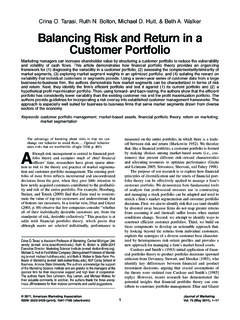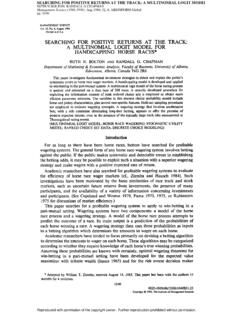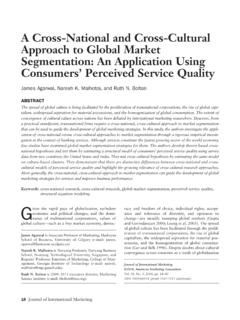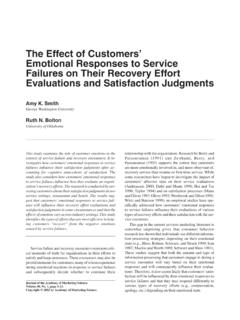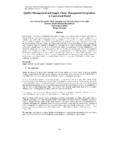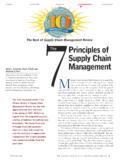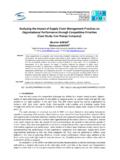Transcription of MANAGING CUSTOMER RELATIONSHIPS - Ruth N. …
1 MANAGING CUSTOMER RELATIONSHIPS 33 CHAPTER 1 MANAGING CUSTOMER RELATIONSHIPSRUTH N. BOLTON AND CRINA O. TARASIA bstractThe CUSTOMER relationship management (CRM) literature recognizes the long-run value of po-tential and current customers. Increased revenues, profits, and shareholder value are the result of marketing activities directed toward developing, maintaining, and enhancing successful com-pany CUSTOMER RELATIONSHIPS . These activities require an in-depth understanding of the underlying sources of value that the firm both derives from customers, as well as delivers to customers.
2 We built our review from the perspective that customers are the building blocks of a firm. In order to endure long-term success, the role of marketing in a firm is to contribute to building strong market assets, including a valuable CUSTOMER portfolio. CRM is an integral part of a company s strategy, and its input should be actively considered in decisions regarding the development of organizational capabilities, the management of value creation, and the allocation of resources. CRM principles provide a strategic and tactical focus for identifying and realizing sources of value for the CUSTOMER and the firm and can guide five key organizational processes: making strategic choices that foster organizational learning, creating value for customers and the firm, MANAGING sources of value , investing resources across functions, organizational units, and channels, and globally optimizing product and CUSTOMER portfolios.
3 For each organizational process, we identify some of the challenges facing marketing scientists and practitioners, and develop an extensive research are increasingly focused on MANAGING CUSTOMER RELATIONSHIPS , the CUSTOMER asset, or CUSTOMER equity. CUSTOMER relationship management (CRM) explicitly recognizes the long-run value of potential and current customers, and seeks to increase revenues, profits, and shareholder value through targeted marketing activities directed toward developing, maintaining, and enhanc-ing successful company- CUSTOMER RELATIONSHIPS (Berry, 1983, p.)
4 25; Morgan and Hunt, 1994, p. 22; Gronroos, 1990 p. 138). These activities require an in-depth understanding of the underlying sources of value the firm both derives from customers and delivers to purpose of this chapter is to describe how companies can effectively cultivate CUSTOMER RELATIONSHIPS and develop CUSTOMER portfolios that increase shareholder value in the long run. We review the extensive literature on CUSTOMER relationship management, CUSTOMER asset management, and CUSTOMER portfolio management, and summarize key findings. The chapter has three major components.
5 First, we define CRM, describe how marketing thinking about CRM has evolved over time, and assess whether CRM principles and systems have improved business performance (to date). Second, we examine (in detail) five organizational processes that we believe are necessary for effective CRM: making strategic choices that foster organizational learning, creating value 4 RUTH N. BOLTON AND CRINA O. TARASIfor customers and the firm, MANAGING sources of value (acquisition, retention, etc.), investing resources across functions, organizational units, and channels, and globally optimizing product and CUSTOMER portfolios.
6 We describe each process, summarize key findings, identify emerging trends and issues, and predict likely future developments (both theoretical and methodological). Our concluding remarks make recommendations about areas where further research is on the Evolution of CUSTOMER relationship ManagementCurrent Definition of CRMA fter surveying many alternative definitions of CRM, Payne and Frow (2005, p. 168) offer the following comprehensive definition, which we will use to frame the discussion in our chapter:CRM is a strategic approach concerned with creating improved shareholder value through the development of appropriate RELATIONSHIPS with key customers and CUSTOMER segments.
7 CRM unites the potential of relationship marketing strategies and IT [information technology] to create profitable, long-term RELATIONSHIPS with customers and other key stakeholders. CRM provides enhanced opportunities to use data and information to both understand customers and co-create value with them. This requires a cross-functional integration of processes, people, operations and marketing capabilities that is enabled through information, technol-ogy and have emphasized different CRM issues depending on whether they are consider-ing a business-to-consumer or business-to-business context.
8 However, we focus on conceptual and methodological principles that are applicable in both contexts, highlighting noteworthy vis- -vis the Domain of MarketingMarketing theory has frequently provided guidance on how firms should react to opportunities, but marketing actions are also able to change the environment and create opportunities (Zeithaml and Zeithaml, 1984). Marketing considered as a general management responsibility plays the crucial roles of (1) navigation through effective market sensing, (2) articulation of the new value proposition, and (3) orchestration by providing the essential glue that ensures a coherent whole (Hunt, 2004, p.)
9 22). CRM enhances these capabilities because it is the outcome of the continuing evolution and integration of marketing ideas and newly available data, technologies and organizational forms (Boulding et al., 2005).CRM principles and systems help organizations to focus on the dual creation of value : the creation of value for shareholders (via long-term firm profitability) and the creation of value or utility for customers (Vargo and Lusch, 2004). These objectives are congruent because relation-ships represent market-based assets that a firm continuously invests in, in order to be viable in the marketplace.
10 Strong RELATIONSHIPS are associated with CUSTOMER loyalty and/or switching costs, which create barriers to competition. Thus RELATIONSHIPS provide a differential advantage by making resources directed to customers more efficient. For example, loyal customers are more responsive to marketing actions and cross-selling (Verhoef, 2003).Marketers sometimes use the term CUSTOMER asset, but customers and assets do not have iden-tical features. The mind-set associated with owning customers is dangerous because CUSTOMER MANAGING CUSTOMER RELATIONSHIPS 5relationships must be carefully managed and CUSTOMER loyalty must be earned (Rust et al.)
